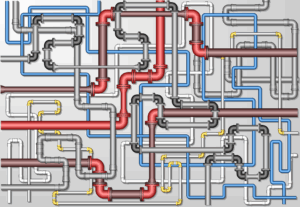Hamsho presented a session at the conference, “Next Generation Technologies: Putting the Talent Puzzle Together,” which focused on the transformative disruption taking place in the wind energy industry. When new technologies are utilized within burgeoning markets by inventive changemakers, business model transformation can take place through dynamic change led by entrepreneurs.
“The American Offshore Wind Academy business model is really transformative,” says Hamsho. “It’s a model that we would like to share with other industries, given that the area of corporate training is a place which very much needs disruptive innovation.”
She continues, “One of the major focuses of the FEI session is how the academy was able to connect the experts within the industry together. Over the past couple of years, there has been a lot of focus on workforce training. In the wind industry, there’s really a need to get the experts together to share their knowledge and advance their careers together. One of the industry CEOs used to call us the Uber for offshore wind knowledge because we’re basically just connecting these experts together and bridging the gap of knowledge in this industry.”
Offshore wind energy is certainly a transformative industry that is focused on developing sustainable energy for this country. The academy is focused in part on partnerships and training. What are your thoughts on this field from an innovation perspective?
Hamsho relates, “In the offshore wind industry, we must really differentiate between innovation and invention. Invention is turning money into ideas. This is basically our team members who are trying to think about the future. Innovation on the other side is turning ideas into money. This is exactly what we’re doing here in the offshore wind industry. Why did Thomas Edison take all the credit for the light bulb? Even though he’s not the one who invented the light bulb, he made it affordable and accessible for every single person in the world to have it, and that’s why he took the credit. This is really what we need to focus on in the offshore wind industry.”
In some ways, the offshore wind industry is just starting out. There’s a lot to strategize upon, in terms of the impact on the planet regarding climate change, developing sustainable solutions, and creating better energy storage and usage. What are your thoughts on the outlook for the offshore wind industry?
“Do you want the good news or the bad news?” says Hamsho. “Let’s start by the fact that in the offshore wind industry, we are 20 years behind Europe. The good news is we’re expected to lead the world by 2050. The bad news also slated for 2050, is that the world population is expected to reach ten billion. One billion of them won’t be able to access any source of energy or they won’t be able to afford it. The energy needed by 2050 will be tripled from the demand that we have today.”
“When we talk about wind energy in general, offshore or onshore, we have enough wind today in the U.S. to energize the nation three years ahead. The challenge though is to make these sources reliable to use by 2050, and that’s really where the innovation takes place. Storage, for example, green hydrogen, other sources of energy that we need to think about by 2050,” she says.
For more of the interview with Serene Hamsho, check out the video from FEI 2024.
Contributor
-

Matthew Kramer is the Digital Editor for All Things Insights & All Things Innovation. He has over 20 years of experience working in publishing and media companies, on a variety of business-to-business publications, websites and trade shows.
View all posts













































































